2017 NISSAN LEAF tire type
[x] Cancel search: tire typePage 389 of 424
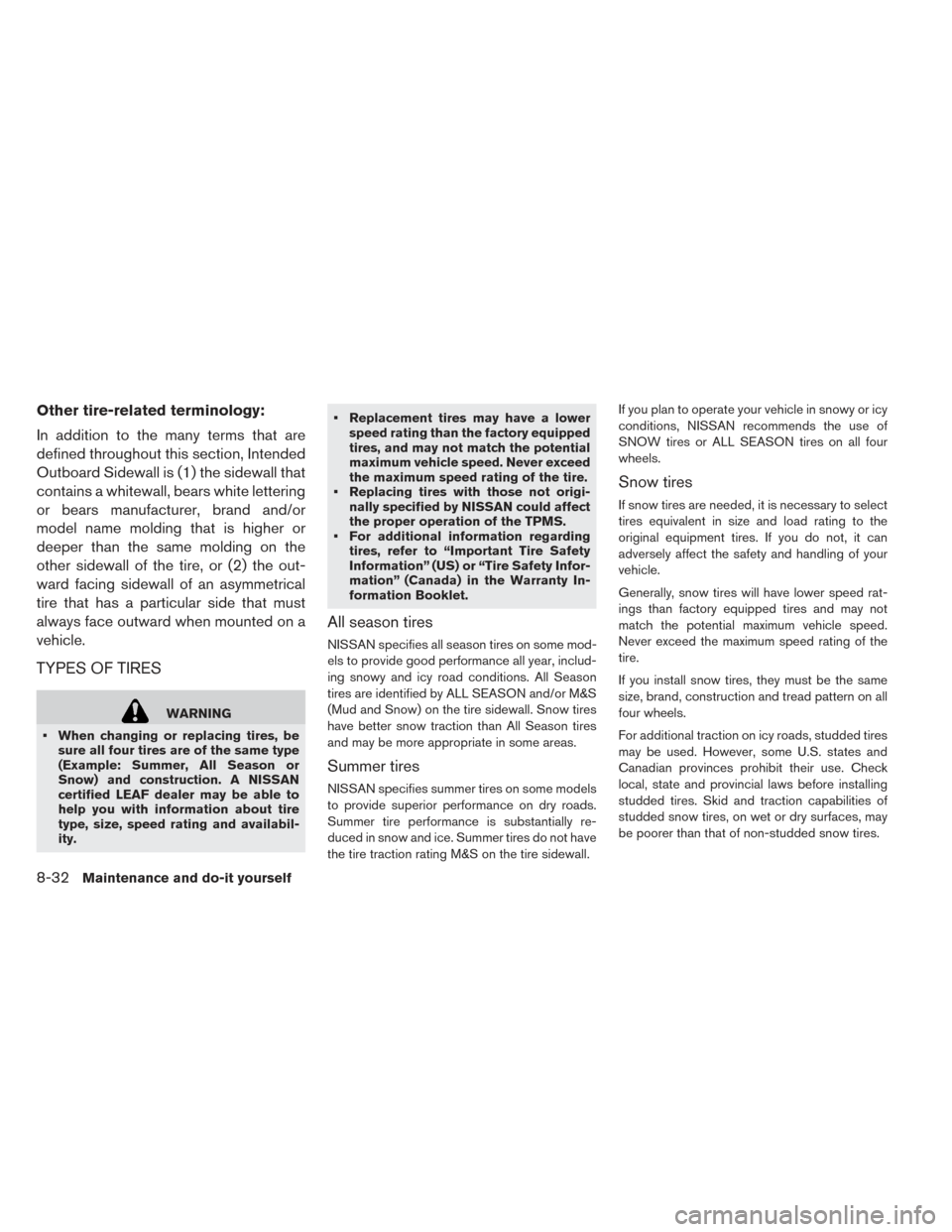
Other tire-related terminology:
In addition to the many terms that are
defined throughout this section, Intended
Outboard Sidewall is (1) the sidewall that
contains a whitewall, bears white lettering
or bears manufacturer, brand and/or
model name molding that is higher or
deeper than the same molding on the
other sidewall of the tire, or (2) the out-
ward facing sidewall of an asymmetrical
tire that has a particular side that must
always face outward when mounted on a
vehicle.
TYPES OF TIRES
WARNING
• When changing or replacing tires, be sure all four tires are of the same type
(Example: Summer, All Season or
Snow) and construction. A NISSAN
certified LEAF dealer may be able to
help you with information about tire
type, size, speed rating and availabil-
ity. • Replacement tires may have a lower
speed rating than the factory equipped
tires, and may not match the potential
maximum vehicle speed. Never exceed
the maximum speed rating of the tire.
• Replacing tires with those not origi- nally specified by NISSAN could affect
the proper operation of the TPMS.
• For additional information regarding tires, refer to “Important Tire Safety
Information” (US) or “Tire Safety Infor-
mation” (Canada) in the Warranty In-
formation Booklet.
All season tires
NISSAN specifies all season tires on some mod-
els to provide good performance all year, includ-
ing snowy and icy road conditions. All Season
tires are identified by ALL SEASON and/or M&S
(Mud and Snow) on the tire sidewall. Snow tires
have better snow traction than All Season tires
and may be more appropriate in some areas.
Summer tires
NISSAN specifies summer tires on some models
to provide superior performance on dry roads.
Summer tire performance is substantially re-
duced in snow and ice. Summer tires do not have
the tire traction rating M&S on the tire sidewall. If you plan to operate your vehicle in snowy or icy
conditions, NISSAN recommends the use of
SNOW tires or ALL SEASON tires on all four
wheels.
Snow tires
If snow tires are needed, it is necessary to select
tires equivalent in size and load rating to the
original equipment tires. If you do not, it can
adversely affect the safety and handling of your
vehicle.
Generally, snow tires will have lower speed rat-
ings than factory equipped tires and may not
match the potential maximum vehicle speed.
Never exceed the maximum speed rating of the
tire.
If you install snow tires, they must be the same
size, brand, construction and tread pattern on all
four wheels.
For additional traction on icy roads, studded tires
may be used. However, some U.S. states and
Canadian provinces prohibit their use. Check
local, state and provincial laws before installing
studded tires. Skid and traction capabilities of
studded snow tires, on wet or dry surfaces, may
be poorer than that of non-studded snow tires.
8-32Maintenance and do-it yourself
Page 390 of 424
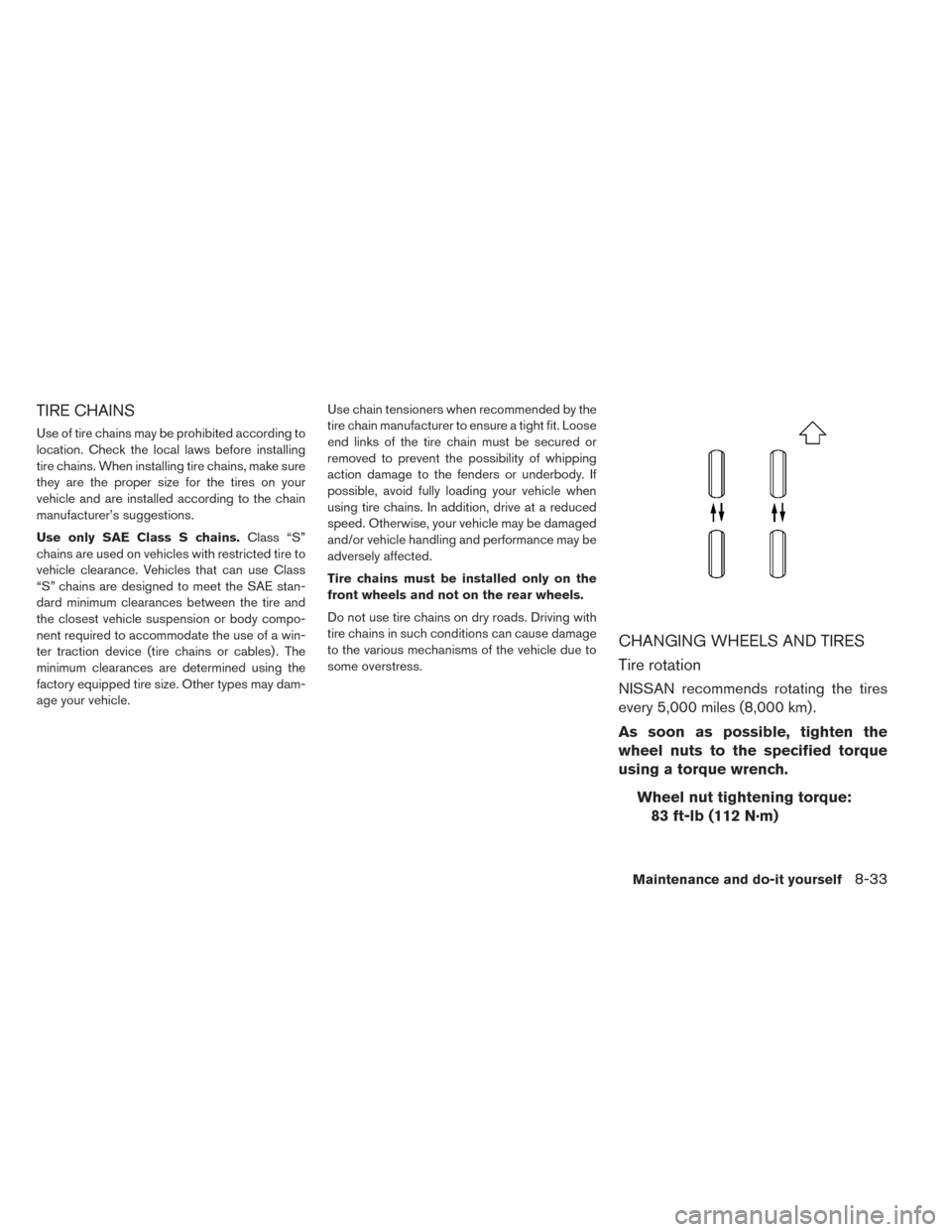
TIRE CHAINS
Use of tire chains may be prohibited according to
location. Check the local laws before installing
tire chains. When installing tire chains, make sure
they are the proper size for the tires on your
vehicle and are installed according to the chain
manufacturer’s suggestions.
Use only SAE Class S chains.Class “S”
chains are used on vehicles with restricted tire to
vehicle clearance. Vehicles that can use Class
“S” chains are designed to meet the SAE stan-
dard minimum clearances between the tire and
the closest vehicle suspension or body compo-
nent required to accommodate the use of a win-
ter traction device (tire chains or cables) . The
minimum clearances are determined using the
factory equipped tire size. Other types may dam-
age your vehicle. Use chain tensioners when recommended by the
tire chain manufacturer to ensure a tight fit. Loose
end links of the tire chain must be secured or
removed to prevent the possibility of whipping
action damage to the fenders or underbody. If
possible, avoid fully loading your vehicle when
using tire chains. In addition, drive at a reduced
speed. Otherwise, your vehicle may be damaged
and/or vehicle handling and performance may be
adversely affected.
Tire chains must be installed only on the
front wheels and not on the rear wheels.
Do not use tire chains on dry roads. Driving with
tire chains in such conditions can cause damage
to the various mechanisms of the vehicle due to
some overstress.
CHANGING WHEELS AND TIRES
Tire rotation
NISSAN recommends rotating the tires
every 5,000 miles (8,000 km) .
As soon as possible, tighten the
wheel nuts to the specified torque
using a torque wrench.
Wheel nut tightening torque:83 ft-lb (112 N·m)
Maintenance and do-it yourself8-33
Page 391 of 424
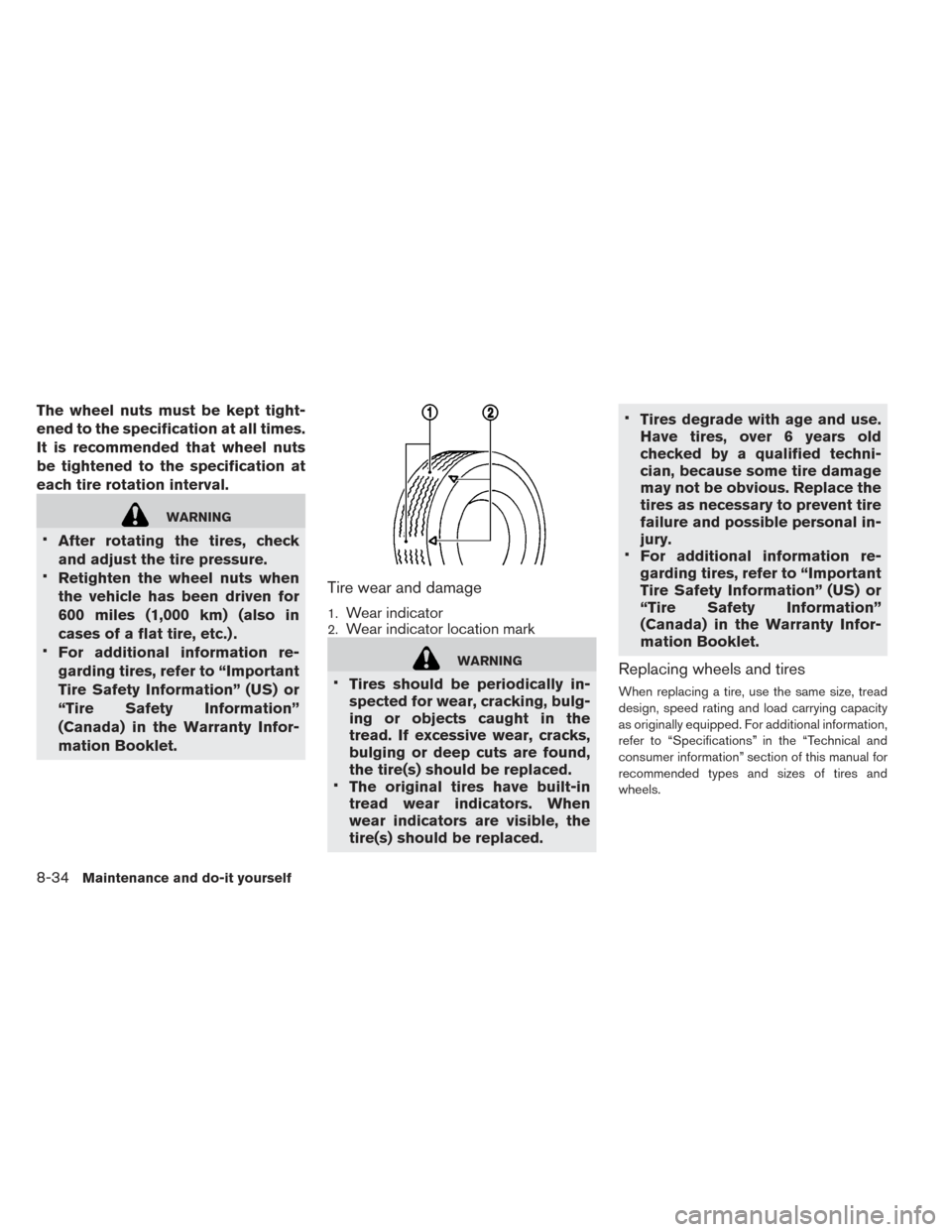
The wheel nuts must be kept tight-
ened to the specification at all times.
It is recommended that wheel nuts
be tightened to the specification at
each tire rotation interval.
WARNING
•
After rotating the tires, check
and adjust the tire pressure.
•Retighten the wheel nuts when
the vehicle has been driven for
600 miles (1,000 km) (also in
cases of a flat tire, etc.) .
•For additional information re-
garding tires, refer to “Important
Tire Safety Information” (US) or
“Tire Safety Information”
(Canada) in the Warranty Infor-
mation Booklet.
Tire wear and damage
1.Wear indicator
2.Wear indicator location mark
WARNING
•
Tires should be periodically in-
spected for wear, cracking, bulg-
ing or objects caught in the
tread. If excessive wear, cracks,
bulging or deep cuts are found,
the tire(s) should be replaced.
•The original tires have built-in
tread wear indicators. When
wear indicators are visible, the
tire(s) should be replaced.
•Tires degrade with age and use.
Have tires, over 6 years old
checked by a qualified techni-
cian, because some tire damage
may not be obvious. Replace the
tires as necessary to prevent tire
failure and possible personal in-
jury.
•For additional information re-
garding tires, refer to “Important
Tire Safety Information” (US) or
“Tire Safety Information”
(Canada) in the Warranty Infor-
mation Booklet.
Replacing wheels and tires
When replacing a tire, use the same size, tread
design, speed rating and load carrying capacity
as originally equipped. For additional information,
refer to “Specifications” in the “Technical and
consumer information” section of this manual for
recommended types and sizes of tires and
wheels.
8-34Maintenance and do-it yourself
Page 398 of 424
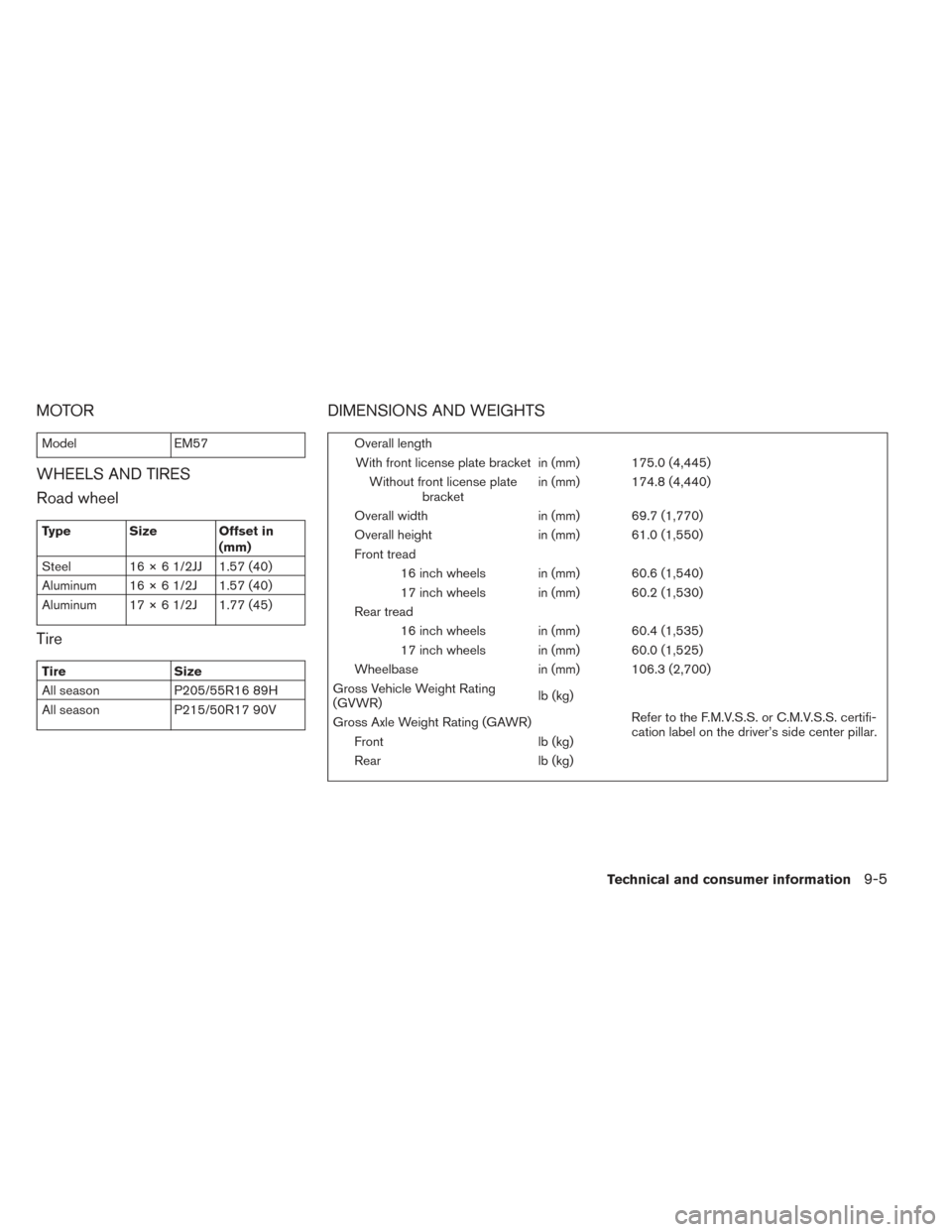
MOTOR
ModelEM57
WHEELS AND TIRES
Road wheel
Type Size Offset in
(mm)
Steel 16 × 6 1/2JJ 1.57 (40)
Aluminum 16 × 6 1/2J 1.57 (40)
Aluminum 17 × 6 1/2J 1.77 (45)
Tire
Tire Size
All season P205/55R16 89H
All season P215/50R17 90V
DIMENSIONS AND WEIGHTS
Overall length
With front license plate bracket in (mm) 175.0 (4,445) Without front license plate bracket in (mm) 174.8 (4,440)
Overall width in (mm) 69.7 (1,770)
Overall height in (mm) 61.0 (1,550)
Front tread 16 inch wheels in (mm) 60.6 (1,540)
17 inch wheels in (mm) 60.2 (1,530)
Rear tread 16 inch wheels in (mm) 60.4 (1,535)
17 inch wheels in (mm) 60.0 (1,525)
Wheelbase in (mm) 106.3 (2,700)
Gross Vehicle Weight Rating
(GVWR) lb (kg)
Refer to the F.M.V.S.S. or C.M.V.S.S. certifi-
cation label on the driver’s side center pillar.
Gross Axle Weight Rating (GAWR)
Front lb (kg)
Rear lb (kg)
Technical and consumer information9-5
Page 420 of 424
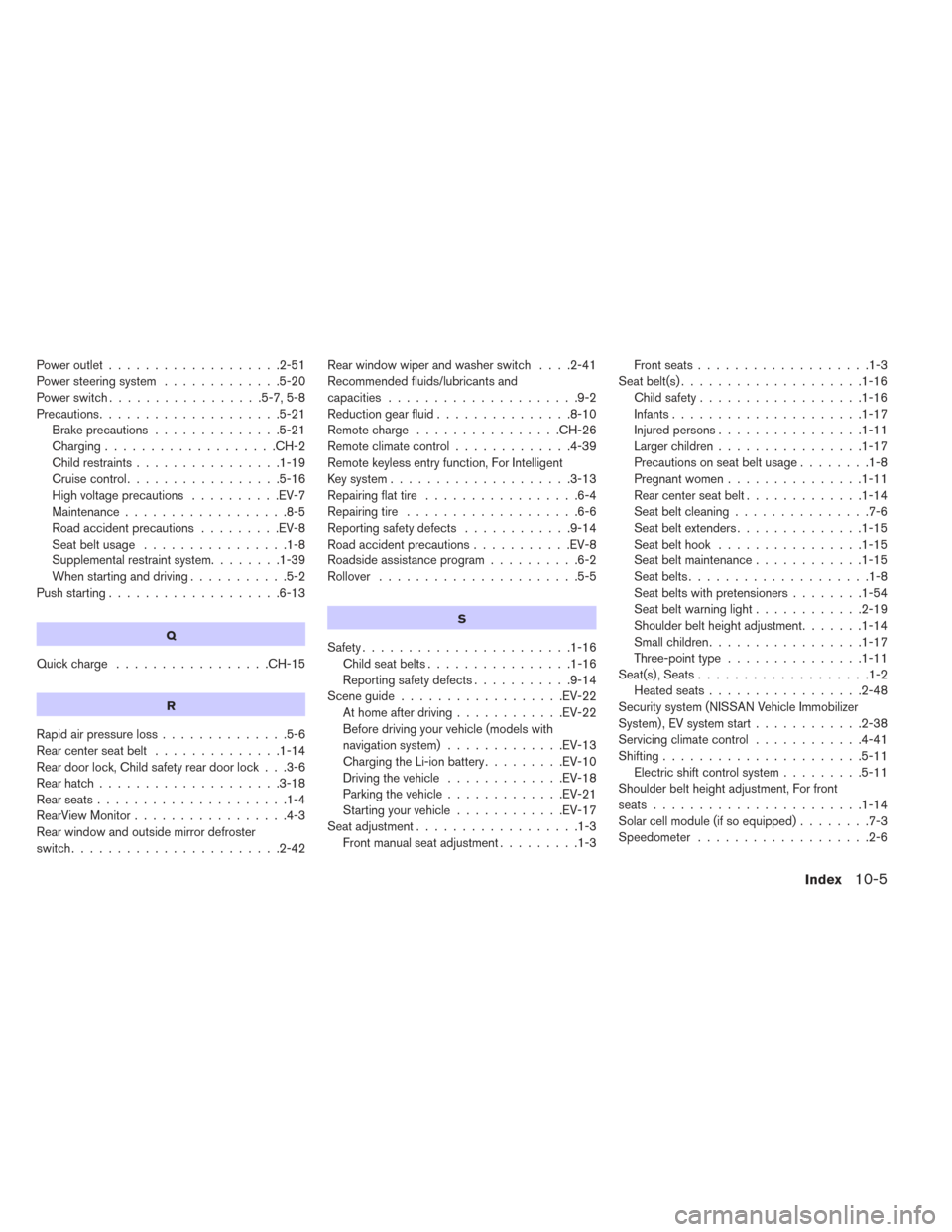
Poweroutlet...................2-51
Power steering system.............5-20
Powerswitch.................5-7,5-8
Precautions....................5-21 Brake precautions ..............5-21
Charging...................CH-2
Child restraints ................1-19
Cruisecontrol.................5-16
High voltage precautions ..........EV-7
Maintenance ..................8-5
Road accident precautions .........EV-8
Seatbeltusage ................1-8
Supplemental restraint system ........1-39
When starting and driving ...........5-2
Push starting ...................6-13
Q
Quickcharge .................CH-15
R
Rapidairpressureloss..............5-6
Rearcenterseatbelt ..............1-14
Rear door lock, Child safety rear door lock . . .3-6
Rear hatch....................3-18
Rearseats.....................1-4
RearView Monitor .................4-3
Rear window and outside mirror defroster
switch .......................2-42 Rear window wiper and washer switch
....2-41
Recommended fluids/lubricants and
capacities .....................9-2
Reduction gear fluid ...............8-10
Remote charge ................CH-26
Remote climate control .............4-39
Remote keyless entry function, For Intelligent
Key system ....................3-13
Repairing flat tire .................6-4
Repairing tire ...................6-6
Reporting safety defects ............9-14
Road accident precautions ...........EV-8
Roadside assistance program ..........6-2
Rollover ......................5-5
S
Safety.......................1-16 Childseatbelts................1-16
Reporting safety defects ...........9-14
Sceneguide..................EV-22 At home after driving ............EV-22
Before driving your vehicle (models with
navigation system) .............EV-13
Charging the Li-ion battery .........EV-10
Driving the vehicle .............EV-18
Parking the vehicle .............EV-21
Starting your vehicle ............EV-17
Seat adjustment ..................1-3
Front manual seat adjustment .........1-3Front seats
...................1-3
Seat belt(s) ....................1-16
Child safety ..................1-16
Infants.....................1-17
Injured persons ................1-11
Larger children ................1-17
Precautions on seat belt usage ........1-8
Pregnant women ...............1-11
Rearcenterseatbelt.............1-14
Seat belt cleaning ...............7-6
Seat belt extenders ..............1-15
Seat belt hook ................1-15
Seat belt maintenance ............1-15
Seatbelts....................1-8
Seatbeltswithpretensioners........1-54
Seatbeltwarninglight............2-19
Shoulder belt height adjustment .......1-14
Small children .................1-17
Three-pointtype...............1-11
Seat(s) , Seats ...................1-2
Heatedseats.................2-48
Security system (NISSAN Vehicle Immobilizer
System) , EV system start ............2-38
Servicing climate control ............4-41
Shifting ......................5-11
Electric shift control system .........5-11
Shoulder belt height adjustment, For front
seats .......................1-14
Solar cell module (if so equipped) ........7-3
Speedometer ...................2-6
Index10-5
Page 421 of 424
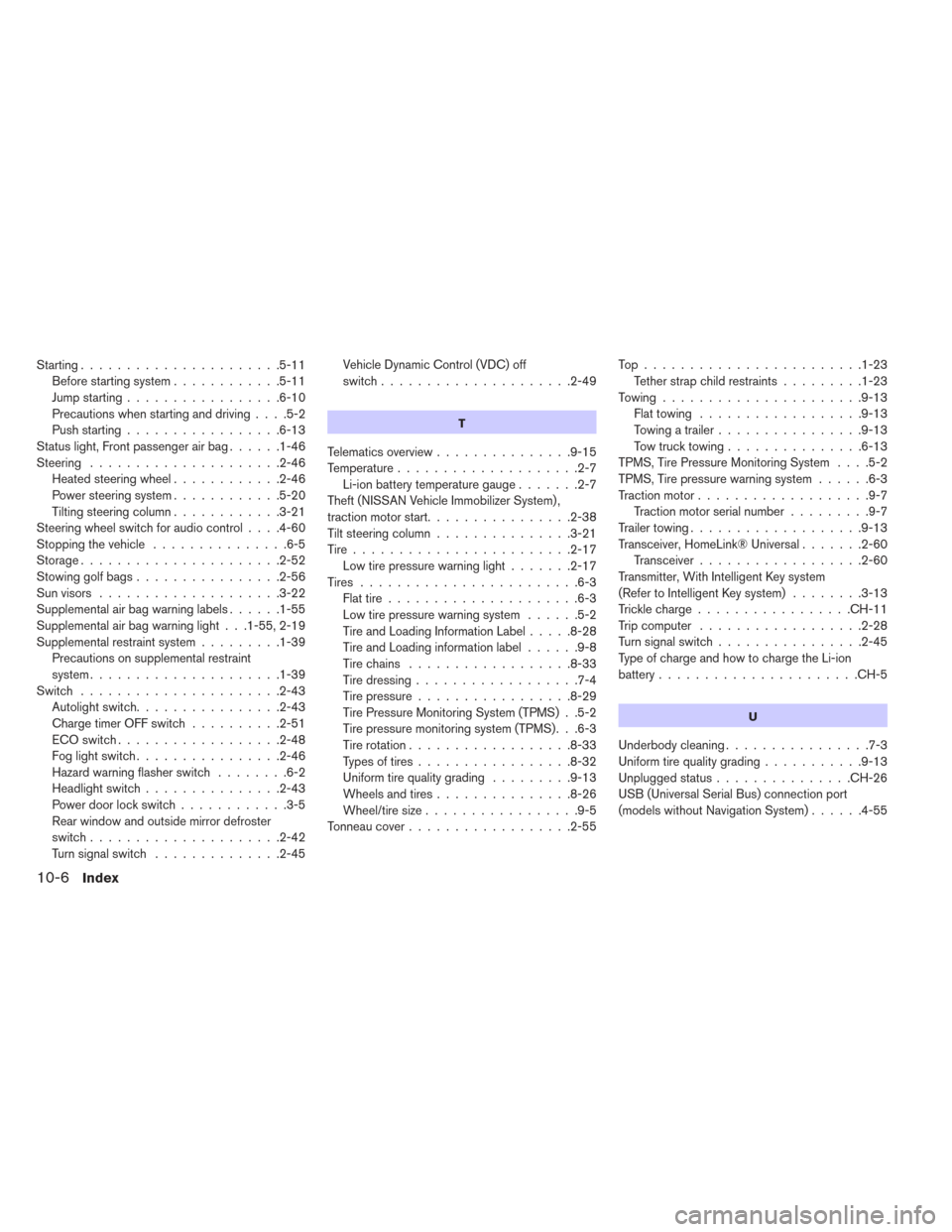
Starting......................5-11
Before starting system ............5-11
Jump starting .................6-10
Precautions when starting and driving ....5-2
Push starting .................6-13
Status light, Front passenger air bag ......1-46
Steering .....................2-46 Heated steering wheel ............2-46
Power steering system ............5-20
Tilting steering column ............3-21
Steering wheel switch for audio control ....4-60
Stoppingthevehicle ...............6-5
Storage......................2-52
Stowing golf bags ................2-56
Sun visors ....................3-22
Supplemental air bag warning labels ......1-55
Supplemental air bag warning light . . .1-55, 2-19
Supplemental restraint system .........1-39
Precautions on supplemental restraint
system.....................1-39
Switch ......................2-43
Autolightswitch................2-43
ChargetimerOFFswitch ..........2-51
ECOswitch..................2-48
Foglightswitch................2-46
Hazard warning flasher switch ........6-2
Headlightswitch...............2-43
Power door lock switch ............3-5
Rear window and outside mirror defroster
switch.....................2-42
Turnsignalswitch ..............2-45 Vehicle Dynamic Control (VDC) off
switch.....................2-49
T
Telematics overview
...............9-15
Temperature ....................2-7
Li-ion battery temperature gauge .......2-7
Theft (NISSAN Vehicle Immobilizer System) ,
traction motor start ................2-38
Tilt steering column ...............3-21
Tire........................2-17 Low tire pressure warning light .......2-17
Tires ........................6-3 Flat tire .....................6-3
Low tire pressure warning system ......5-2
Tire and Loading Information Label .....8-28
Tire and Loading information label ......9-8
Tirechains ..................8-33
Tire dressing ..................7-4
Tire pressure .................8-29
Tire Pressure Monitoring System (TPMS) . .5-2
Tire pressure monitoring system (TPMS). . .6-3
Tire rotation ..................8-33
Types of tires .................8-32
Uniform tire quality grading .........9-13
Wheels and tires ...............8-26
Wheel/tire size .................9-5
Tonneau cover ..................2-55 Top........................1-23
Tether strap child restraints .........1-23
Towing......................9-13 Flattowing ..................9-13
Towing a trailer ................9-13
Towtrucktowing...............6-13
TPMS, Tire Pressure Monitoring System ....5-2
TPMS, Tire pressure warning system ......6-3
Traction motor ...................9-7
Traction motor serial number .........9-7
Trailer towing ...................9-13
Transceiver, HomeLink® Universal .......2-60
Transceiver ..................2-60
Transmitter, With Intelligent Key system
(Refer to Intelligent Key system) ........3-13
Trickle charge .................CH-11
Trip computer ..................2-28
Turn signal switch ................2-45
Type of charge and how to charge the Li-ion
battery ......................CH-5
U
Underbody cleaning ................7-3
Uniform tire quality grading ...........9-13
Unplugged status ...............CH-26
USB (Universal Serial Bus) connection port
(models without Navigation System) ......4-55
10-6Index